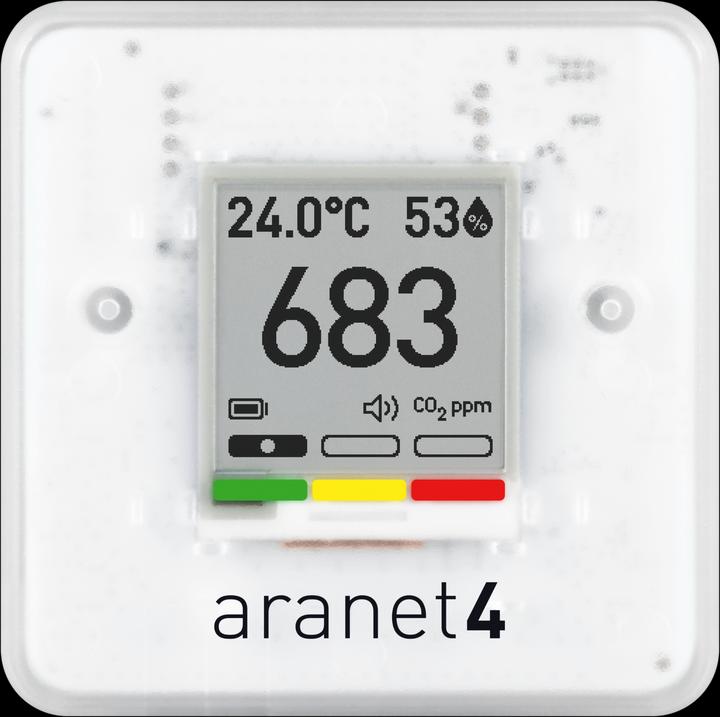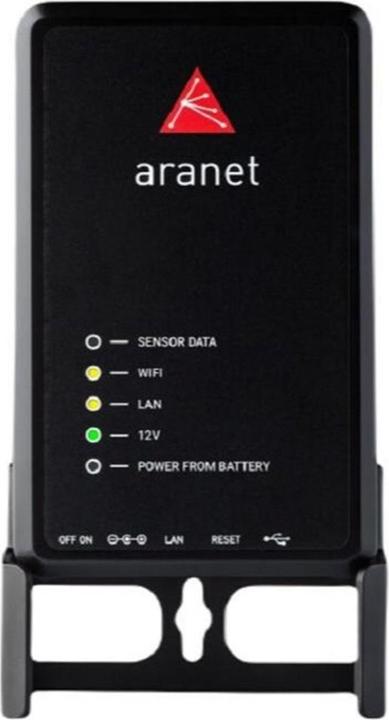

Measuring CO₂ – what meters can and cannot do
There are CO₂ meters in every price range. And cheap ones aren’t necessarily useless. But expensive models are often more accurate and offer an expanded arsenal in the fight against bad air.
If there’s one thing the pandemic has taught us, hopefully it’s that viruses and bacteria especially accumulate indoors – and that the risk of infection is higher, especially when the air quality is poor. In other words, air with a high carbon dioxide content, or air that’s been breathed in and out of many pairs of lungs.
Sure, the Covid pandemic was eventually declared over by politicians. But if you want to protect yourself from viral diseases, you should avoid poorly ventilated rooms. According to a study by Empa, the Swiss Federal Laboratories for Materials Science and Technology conducted in classrooms in the Grisons, breathing fresh air makes you up to 63 per cent less likely to catch a disease and allows you to experience much better concentration, among other things. A study at Harvard Research came to similar conclusions.
But how can you tell how good the air is in a room? Sure, you can often smell when the air is bad – just walk into a stuffy meeting room that’s been occupied for hours. But if you’re stuck in a meeting room yourself, chances are you won’t notice the air getting worse and worse. This is where CO₂ sensors come into play. I’ve tested a few over the past months.
The Sensirion: small but mighty
The Sensirion is the smallest meter I tested. It costs just under 60 francs or euros (as of October 2023) and is the size of my thumb. It runs on just 200 mA and connects to the power via USB. You can use the Sensirion sensor with any USB port – for example on your laptop or on a USB charging plug.

Technology-wise, the Sensirion is made of a relatively simple circuit board with an LED and an air quality sensor, the SCD41. Depending on the concentration of CO₂ measured in the room, the LED lights up as follows:
- Green between 400 and 1,000 ppm CO₂
- Yellow between 1,001 and 1,600 ppm
- Red at over 1,600 ppm.
This makes it very quick and easy to recognise the right time to air out the room, namely when the light is yellow or red.

Source: Martin Jungfer
Additionally, there’s a Bluetooth Low Energy (BLE) module built into the Sensirion’s circuit board. It transfers measurement data every few seconds from the sensor to the My Ambience smartphone app. In the app (available for Android and iOS), you can then view the development of the CO₂ concentration as a line graph.

Source: Martin Jungfer
If required, the data can also be read out via API. You can also display data from other sensors in the app. Sensirion is a Swiss company based in Stäfa which offers other environmental sensors that, for example, measure formaldehyde, gas and humidity. You can also use these sensors with Raspberry devices, for example. If you’re interested, Sensirion provides good documentation, including on GitHub.
The lowdown: a sensor with many possibilities
The CO₂ sensor is practical; the LED indicates how good the air quality is in a simple and understandable way. In an office or classroom, all you’d need to do is plug it into a laptop for everyone to see the air quality. In addition, you can view measurements over longer periods of time and read out data in the app. The only drawback: USB-A is increasingly being replaced by USB-C; as a result, the Sensirion sensor no longer fits in new MacBooks, for example.
Aranet 4 Home: the independent long-distancer
With a price of over 150 francs or euros, the Aranet 4 is a rather expensive sensor, but it can do quite a bit in return. Above all, it impresses with its quasi-infinite runtime. Equipped with two LR6/AA batteries, the sensor, manufactured by a Latvian company, lasts months at a time.
In the «Home» version I use every day, there’s a small e-ink display that shows information on temperature, humidity and CO₂. The carbon dioxide value is nearly three times the size of the other stats. Under the bottom edge of the display, there’s a colour scale – green, yellow, red – representing good, medium and poor air quality. Instead of an LED light, there’s a black bar on the display above the colour scale that marks the current air quality. Aranet switches to red a bit earlier than the Sensirion sensor, namely from 1,400 ppm (instead of 1,600 ppm).

Source: Martin Jungfer
The square case measures only 7×7 centimetres. At the back, there’s a recess that allows you to hang the sensor using a nail, for example. Then again, the Aranet’s modest aesthetics rather speak for a not-quite-so-prominent placement. The semi-transparent plastic lets the circuit board show through. In addition to its sensors, the Aranet 4 also contains a Bluetooth module, used to connect to the app (available for iOS and Android).
In the app, you can view progress charts – also for air pressure. In the app, you can also set how often the display updates. With an interval of five or ten minutes, the Aranet will run not only for months, but two to three years on a single pair of batteries. I can also set the app to vibrate if the CO₂ concentration exceeds 1,400 ppm – convenient.

Source: Martin Jungfer
Even though the app is comprehensive and provides a lot of data, Aranet also offers a cloud solution for professional use. This is useful when you need to monitor multiple rooms with multiple sensors. In addition to the Aranet 4, you’ll then need a hub, cloud account and subscription. For private use, this is likely overkill.
Conclusion: happily wireless
I almost always take the Aranet 4 Home with me when I’m out and about. On the train, I place it on the little table next to the seats. In a crowded aeroplane, it showed me frighteningly high values even before takeoff. Even without the app, the Aranet 4 offers a wealth of information without having to worry about the power supply.
Technoline WL 1030: inexpensive and app-free
The WL 1030 looks like a weather station. The black, plastic device stands at almost 14 centimetres and needs a constant power supply. It comes with its own plug; no USB cable will help you here.
The fact that Technoline doesn’t have an app speaks for a different target group. The display is the selling point of the WL 1030. It shows the current CO₂ content in the form of a speedometer. Below it is an additional field that indicates the air quality and advises you to air out the room – for example, if the air quality is «medium». It also displays the temperature, accurate to one tenth of a degree, as well as humidity.
Buttons on the back allow you to adjust the brightness of the three-colour display in two steps. You can also activate an acoustic alarm. If you have the patience to do the whole press-one-button-at-a-time-then-arrow-up shebang, you can define your own upper and lower limits on the WL 1030 for triggering the alarm. Operating concepts like this really belong back in the last millennium. You have no option but to consult the instruction manual. But changing the limits isn’t really necessary. The default settings are good: Technoline recommends airing out the room from a value of 1,000 ppm CO₂, and says it’s necessary starting at 1,500 ppm.

Source: Martin Jungfer
The lowdown: for the technologically undemanding
The WL 1030 is for people who like to look at as much weather data as possible without having a smartphone at hand to call up an app. The Technoline WL 1030 is the kind of device you place in a given spot – and leave it there for a very long time. You don’t have much of a choice, as its mobility is very limited due to the power supply.
Accurate enough to be reminded to air out the room
No matter which CO₂ meter you choose, each one will remind you when it’s time to let in some fresh air. Doing so causes the viral load to drop. And the lower CO₂ concentration helps your focus.
Opening windows can be a touchy topic, especially in open-plan offices. A measuring device can take on the role of a neutral watchdog: is the light on or the device beeping? Then it’s time to open the windows for a few minutes until the value has moved out of the yellow or red range. It’s less useful on a plane or train, where it might be better not to know just how bad the air is.
In principle, all CO₂ sensors work with the same technology: the CO₂ content is determined via a so-called non-dispersive infrared sensor (NDIR). But there are definitely differences in quality. I had deviations in the range of 100 to 150 ppm across the three devices. Sensirion relies on a small photoacoustic spectroscope sensor, developed in-house. As with the Aranet, the values tended to be higher, while the Technoline showed somewhat lower ones. In everyday life, however, these differences aren’t critical. What’s more interesting are the options for recording and evaluating data over longer periods of time. If you want that, you’ll have to go for a «smarter» device, such as those from Sensirion or Aranet, which works with an app.
Header image: Martin JungferJournalist since 1997. Stopovers in Franconia (or the Franken region), Lake Constance, Obwalden, Nidwalden and Zurich. Father since 2014. Expert in editorial organisation and motivation. Focus on sustainability, home office tools, beautiful things for the home, creative toys and sports equipment.





